Business Management at Sustainable Level: Report, [University Name]
VerifiedAdded on 2022/10/18
|9
|1881
|10
Report
AI Summary
This report delves into the core principles of sustainable business management, emphasizing the optimal design of sustainable business models. It highlights the crucial role of technology, innovation, process improvement, collaboration, sustainability reporting, and green supply chains in achieving this optimal design. The report further explores eco-efficiency and its synergy with sustainability in the long term, emphasizing the benefits across social, environmental, and economic factors. It underscores the significance of operating within an optimal industrial ecosystem to foster overall economic and social development. The analysis encompasses the importance of adapting sustainability audits to atypical business models and the challenges faced in measuring sustainability performance. The report provides a comprehensive overview of the key elements that contribute to a successful and sustainable business strategy, from the reduction of carbon footprint to the promotion of green practices and the fostering of social responsibility.
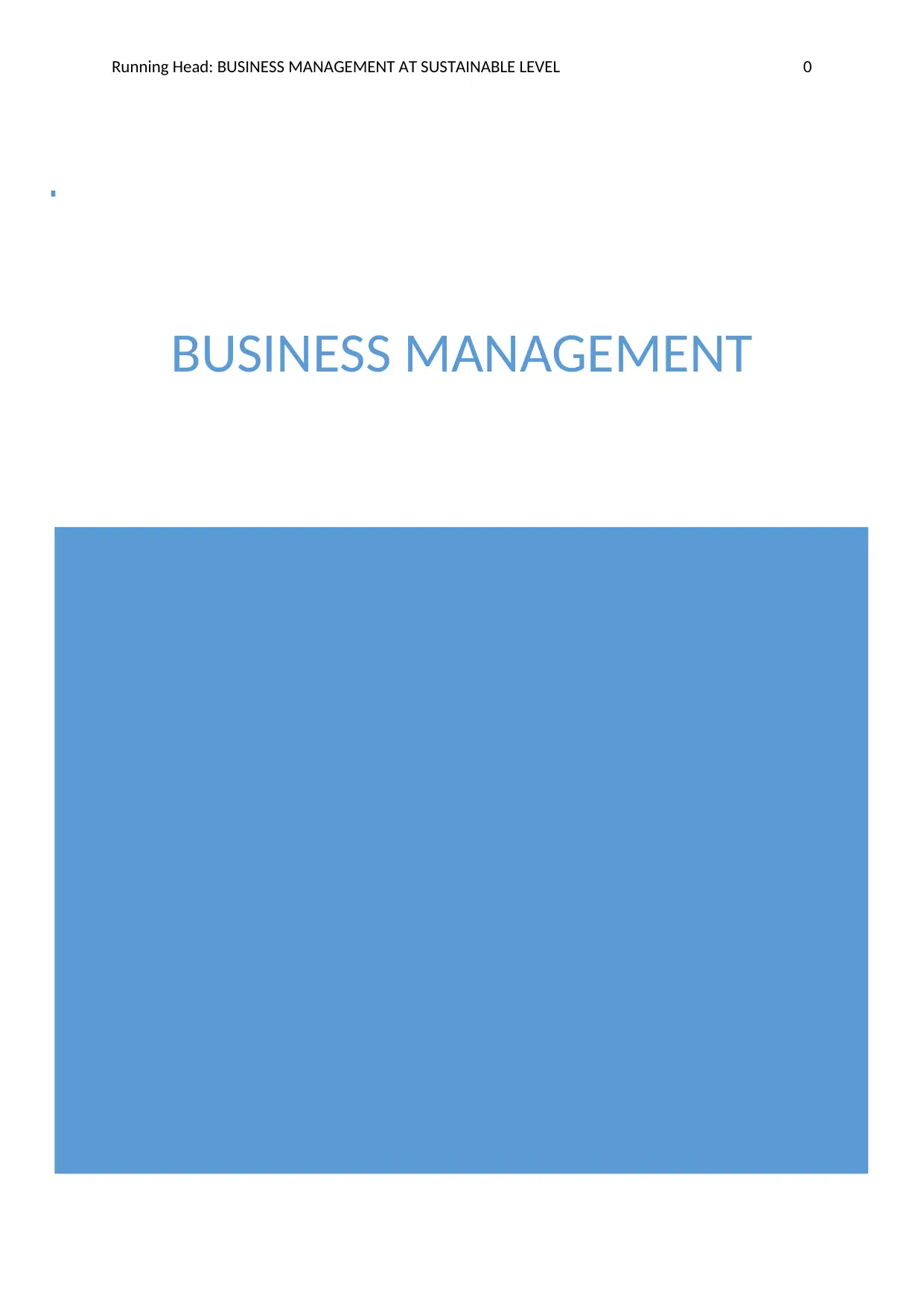
BUSINESS MANAGEMENT
Running Head: BUSINESS MANAGEMENT AT SUSTAINABLE LEVEL 0
Running Head: BUSINESS MANAGEMENT AT SUSTAINABLE LEVEL 0
Paraphrase This Document
Need a fresh take? Get an instant paraphrase of this document with our AI Paraphraser
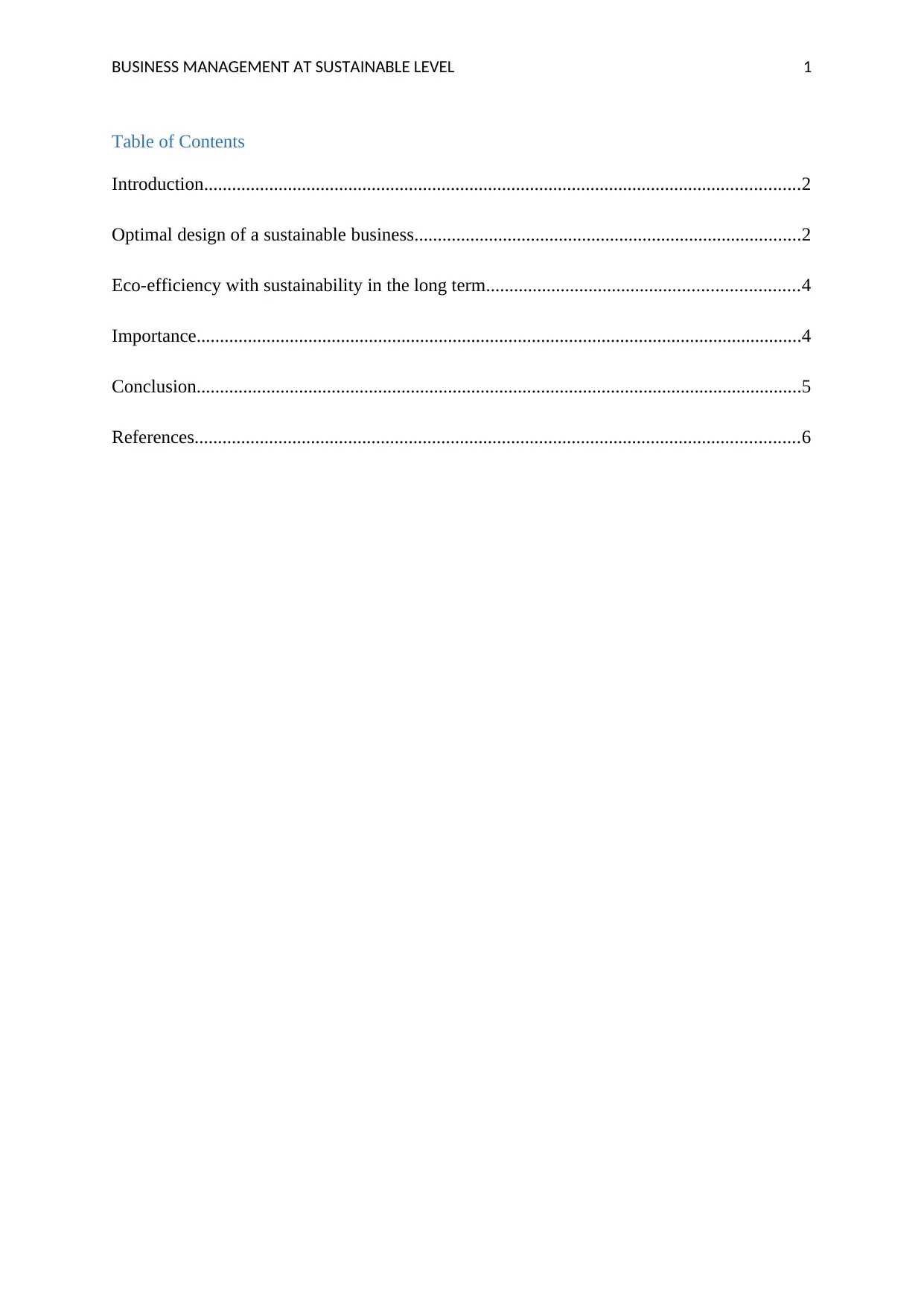
BUSINESS MANAGEMENT AT SUSTAINABLE LEVEL 1
Table of Contents
Introduction................................................................................................................................2
Optimal design of a sustainable business...................................................................................2
Eco-efficiency with sustainability in the long term...................................................................4
Importance..................................................................................................................................4
Conclusion..................................................................................................................................5
References..................................................................................................................................6
Table of Contents
Introduction................................................................................................................................2
Optimal design of a sustainable business...................................................................................2
Eco-efficiency with sustainability in the long term...................................................................4
Importance..................................................................................................................................4
Conclusion..................................................................................................................................5
References..................................................................................................................................6
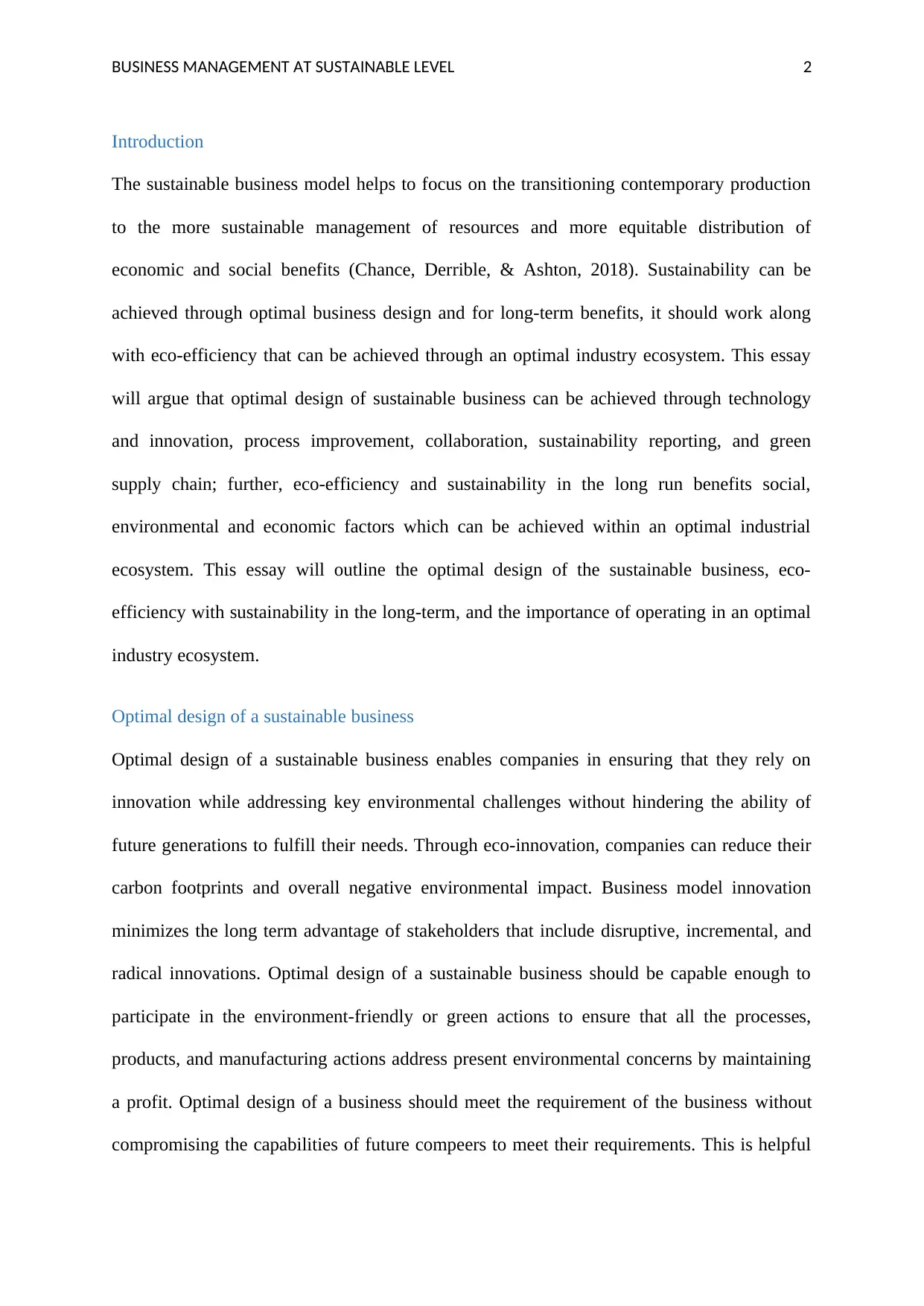
BUSINESS MANAGEMENT AT SUSTAINABLE LEVEL 2
Introduction
The sustainable business model helps to focus on the transitioning contemporary production
to the more sustainable management of resources and more equitable distribution of
economic and social benefits (Chance, Derrible, & Ashton, 2018). Sustainability can be
achieved through optimal business design and for long-term benefits, it should work along
with eco-efficiency that can be achieved through an optimal industry ecosystem. This essay
will argue that optimal design of sustainable business can be achieved through technology
and innovation, process improvement, collaboration, sustainability reporting, and green
supply chain; further, eco-efficiency and sustainability in the long run benefits social,
environmental and economic factors which can be achieved within an optimal industrial
ecosystem. This essay will outline the optimal design of the sustainable business, eco-
efficiency with sustainability in the long-term, and the importance of operating in an optimal
industry ecosystem.
Optimal design of a sustainable business
Optimal design of a sustainable business enables companies in ensuring that they rely on
innovation while addressing key environmental challenges without hindering the ability of
future generations to fulfill their needs. Through eco-innovation, companies can reduce their
carbon footprints and overall negative environmental impact. Business model innovation
minimizes the long term advantage of stakeholders that include disruptive, incremental, and
radical innovations. Optimal design of a sustainable business should be capable enough to
participate in the environment-friendly or green actions to ensure that all the processes,
products, and manufacturing actions address present environmental concerns by maintaining
a profit. Optimal design of a business should meet the requirement of the business without
compromising the capabilities of future compeers to meet their requirements. This is helpful
Introduction
The sustainable business model helps to focus on the transitioning contemporary production
to the more sustainable management of resources and more equitable distribution of
economic and social benefits (Chance, Derrible, & Ashton, 2018). Sustainability can be
achieved through optimal business design and for long-term benefits, it should work along
with eco-efficiency that can be achieved through an optimal industry ecosystem. This essay
will argue that optimal design of sustainable business can be achieved through technology
and innovation, process improvement, collaboration, sustainability reporting, and green
supply chain; further, eco-efficiency and sustainability in the long run benefits social,
environmental and economic factors which can be achieved within an optimal industrial
ecosystem. This essay will outline the optimal design of the sustainable business, eco-
efficiency with sustainability in the long-term, and the importance of operating in an optimal
industry ecosystem.
Optimal design of a sustainable business
Optimal design of a sustainable business enables companies in ensuring that they rely on
innovation while addressing key environmental challenges without hindering the ability of
future generations to fulfill their needs. Through eco-innovation, companies can reduce their
carbon footprints and overall negative environmental impact. Business model innovation
minimizes the long term advantage of stakeholders that include disruptive, incremental, and
radical innovations. Optimal design of a sustainable business should be capable enough to
participate in the environment-friendly or green actions to ensure that all the processes,
products, and manufacturing actions address present environmental concerns by maintaining
a profit. Optimal design of a business should meet the requirement of the business without
compromising the capabilities of future compeers to meet their requirements. This is helpful
⊘ This is a preview!⊘
Do you want full access?
Subscribe today to unlock all pages.

Trusted by 1+ million students worldwide
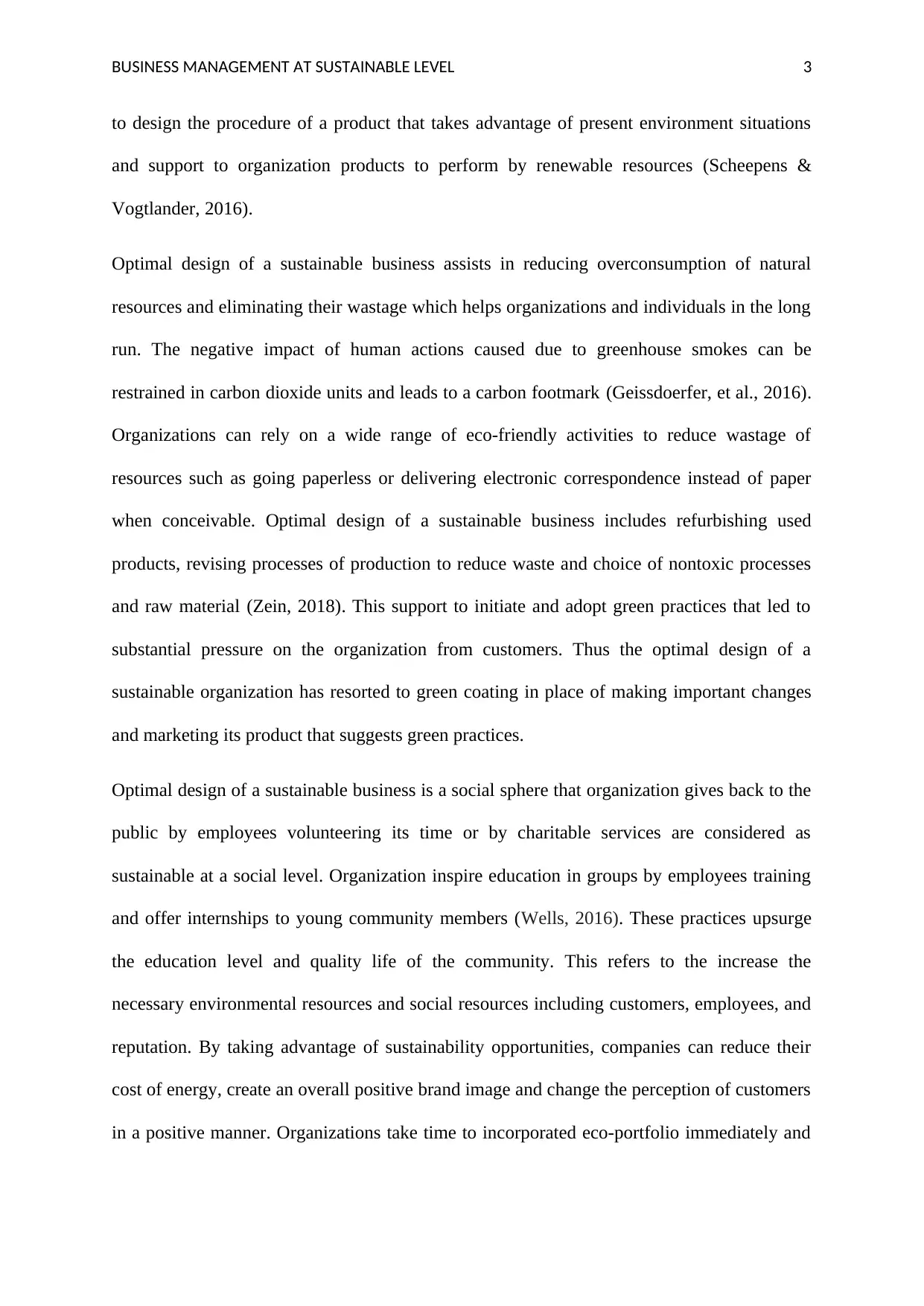
BUSINESS MANAGEMENT AT SUSTAINABLE LEVEL 3
to design the procedure of a product that takes advantage of present environment situations
and support to organization products to perform by renewable resources (Scheepens &
Vogtlander, 2016).
Optimal design of a sustainable business assists in reducing overconsumption of natural
resources and eliminating their wastage which helps organizations and individuals in the long
run. The negative impact of human actions caused due to greenhouse smokes can be
restrained in carbon dioxide units and leads to a carbon footmark (Geissdoerfer, et al., 2016).
Organizations can rely on a wide range of eco-friendly activities to reduce wastage of
resources such as going paperless or delivering electronic correspondence instead of paper
when conceivable. Optimal design of a sustainable business includes refurbishing used
products, revising processes of production to reduce waste and choice of nontoxic processes
and raw material (Zein, 2018). This support to initiate and adopt green practices that led to
substantial pressure on the organization from customers. Thus the optimal design of a
sustainable organization has resorted to green coating in place of making important changes
and marketing its product that suggests green practices.
Optimal design of a sustainable business is a social sphere that organization gives back to the
public by employees volunteering its time or by charitable services are considered as
sustainable at a social level. Organization inspire education in groups by employees training
and offer internships to young community members (Wells, 2016). These practices upsurge
the education level and quality life of the community. This refers to the increase the
necessary environmental resources and social resources including customers, employees, and
reputation. By taking advantage of sustainability opportunities, companies can reduce their
cost of energy, create an overall positive brand image and change the perception of customers
in a positive manner. Organizations take time to incorporated eco-portfolio immediately and
to design the procedure of a product that takes advantage of present environment situations
and support to organization products to perform by renewable resources (Scheepens &
Vogtlander, 2016).
Optimal design of a sustainable business assists in reducing overconsumption of natural
resources and eliminating their wastage which helps organizations and individuals in the long
run. The negative impact of human actions caused due to greenhouse smokes can be
restrained in carbon dioxide units and leads to a carbon footmark (Geissdoerfer, et al., 2016).
Organizations can rely on a wide range of eco-friendly activities to reduce wastage of
resources such as going paperless or delivering electronic correspondence instead of paper
when conceivable. Optimal design of a sustainable business includes refurbishing used
products, revising processes of production to reduce waste and choice of nontoxic processes
and raw material (Zein, 2018). This support to initiate and adopt green practices that led to
substantial pressure on the organization from customers. Thus the optimal design of a
sustainable organization has resorted to green coating in place of making important changes
and marketing its product that suggests green practices.
Optimal design of a sustainable business is a social sphere that organization gives back to the
public by employees volunteering its time or by charitable services are considered as
sustainable at a social level. Organization inspire education in groups by employees training
and offer internships to young community members (Wells, 2016). These practices upsurge
the education level and quality life of the community. This refers to the increase the
necessary environmental resources and social resources including customers, employees, and
reputation. By taking advantage of sustainability opportunities, companies can reduce their
cost of energy, create an overall positive brand image and change the perception of customers
in a positive manner. Organizations take time to incorporated eco-portfolio immediately and
Paraphrase This Document
Need a fresh take? Get an instant paraphrase of this document with our AI Paraphraser

BUSINESS MANAGEMENT AT SUSTAINABLE LEVEL 4
practiced strategies that consist of innovation, process improvement, collaboration, and
sustainability reporting (Prause, 2015).
Factors such as technology and innovation, collaboration, process improvement,
sustainability reporting, and green supply chain are crucial to achieving an optimal design of
sustainable business. Companies can implement sustainable business practices through
technology and innovation which focuses on organization ability to change goods and
services towards sustainable best practices and less waste production. Through collaboration,
corporations can ensure that the formation of the network works by same or partner
organizations to facilitate knowledge propels innovations and knowledge sharing. Regular
process improvement and surveying are vital to reduce waste. Organization-wide
sustainability plan consists of the integration of improved and new processes. Furthermore,
sustainability reporting is necessary to monitor whether organizations are performing to
achieve their sustainable goals or not. These objectives are integrated into the mission at the
corporate level. The green supply chain is also relevant because procurement at a sustainable
level is the most important for the strategy of sustainability as an organization's impact on the
environment is higher than the consumption of the product.
Eco-efficiency with sustainability in the long term
Both eco-efficiency and sustainability practices are crucial to achieving long-term success
since they work together to create an optimal industrial ecosystem. The relationship between
economic growths, human well-being and the accomplishment of a supportable future has a
complex and long intellectual history. Eco-efficiency is the primary tool to promote
transformation from unsustainable development to sustainable development. This has the
base to generate more goods and services by use of a few resources and generate less waste
and pollution. On the other hand, sustainable business generates inputs and output that are
interchangeable (Upward, & Jones, 2016). A perfectly sustainable business generate inputs
practiced strategies that consist of innovation, process improvement, collaboration, and
sustainability reporting (Prause, 2015).
Factors such as technology and innovation, collaboration, process improvement,
sustainability reporting, and green supply chain are crucial to achieving an optimal design of
sustainable business. Companies can implement sustainable business practices through
technology and innovation which focuses on organization ability to change goods and
services towards sustainable best practices and less waste production. Through collaboration,
corporations can ensure that the formation of the network works by same or partner
organizations to facilitate knowledge propels innovations and knowledge sharing. Regular
process improvement and surveying are vital to reduce waste. Organization-wide
sustainability plan consists of the integration of improved and new processes. Furthermore,
sustainability reporting is necessary to monitor whether organizations are performing to
achieve their sustainable goals or not. These objectives are integrated into the mission at the
corporate level. The green supply chain is also relevant because procurement at a sustainable
level is the most important for the strategy of sustainability as an organization's impact on the
environment is higher than the consumption of the product.
Eco-efficiency with sustainability in the long term
Both eco-efficiency and sustainability practices are crucial to achieving long-term success
since they work together to create an optimal industrial ecosystem. The relationship between
economic growths, human well-being and the accomplishment of a supportable future has a
complex and long intellectual history. Eco-efficiency is the primary tool to promote
transformation from unsustainable development to sustainable development. This has the
base to generate more goods and services by use of a few resources and generate less waste
and pollution. On the other hand, sustainable business generates inputs and output that are
interchangeable (Upward, & Jones, 2016). A perfectly sustainable business generate inputs

BUSINESS MANAGEMENT AT SUSTAINABLE LEVEL 5
and outputs that are substitutable. Sustainable business has zero waste and needs zero input
outer of growth. For example, IT equipment generates heat like a waste of product. Heat is
also ducted out of the attendant room by a fan or chilled by an Air conditioner unit. Although
there are minor differences; however, Eco-efficiency by sustainability in the long term can be
achieved in the long term without a heavier impact on the rate of short-run economic growth.
This is preventing experts from getting goals of supporting the environment (Dyllick & Muff,
2016). These require additional energy. IT rooms by cooled airs allow heat to dissolve
outside in chiller climes. It is an eco-efficient solution. Ducting the waste of heat in nearby
workplaces to heat workers is an energy-efficient victory that has a sustainable solution. This
will have zero waste. Providing electricity for the area of IT by a renewable source of energy
will give a perfectly sustainable system (Arnette & Barry, 2019).
Importance
Operating in an optimal industrial ecosystem is important for companies to sustain the overall
economic development of the nation. This is the major issue that sounds economically and
affects business by extension, employability, and jobs (Boons, 2017). This is about to deliver
the incentives for business and other organizations to adhere to sustainable guidelines beyond
normal legal needs. This support to foster and increase incentives for the average person that
person achieve and take as a group effect in cumulative areas. Economic development is to
provide the quality life without compromising quality life in the developing a world and
decrease the financial burden and red tape of doing the correct thing.
Another importance of an optimal industrial ecosystem is the achievement of social
development. This holds many facets to this pillar. This help to facilitate awareness and
legislation production of people health from harmful activities and pollution of business. This
establishes strong checks and legal programs to ensure people wellness and health strongly
and outputs that are substitutable. Sustainable business has zero waste and needs zero input
outer of growth. For example, IT equipment generates heat like a waste of product. Heat is
also ducted out of the attendant room by a fan or chilled by an Air conditioner unit. Although
there are minor differences; however, Eco-efficiency by sustainability in the long term can be
achieved in the long term without a heavier impact on the rate of short-run economic growth.
This is preventing experts from getting goals of supporting the environment (Dyllick & Muff,
2016). These require additional energy. IT rooms by cooled airs allow heat to dissolve
outside in chiller climes. It is an eco-efficient solution. Ducting the waste of heat in nearby
workplaces to heat workers is an energy-efficient victory that has a sustainable solution. This
will have zero waste. Providing electricity for the area of IT by a renewable source of energy
will give a perfectly sustainable system (Arnette & Barry, 2019).
Importance
Operating in an optimal industrial ecosystem is important for companies to sustain the overall
economic development of the nation. This is the major issue that sounds economically and
affects business by extension, employability, and jobs (Boons, 2017). This is about to deliver
the incentives for business and other organizations to adhere to sustainable guidelines beyond
normal legal needs. This support to foster and increase incentives for the average person that
person achieve and take as a group effect in cumulative areas. Economic development is to
provide the quality life without compromising quality life in the developing a world and
decrease the financial burden and red tape of doing the correct thing.
Another importance of an optimal industrial ecosystem is the achievement of social
development. This holds many facets to this pillar. This help to facilitate awareness and
legislation production of people health from harmful activities and pollution of business. This
establishes strong checks and legal programs to ensure people wellness and health strongly
⊘ This is a preview!⊘
Do you want full access?
Subscribe today to unlock all pages.

Trusted by 1+ million students worldwide
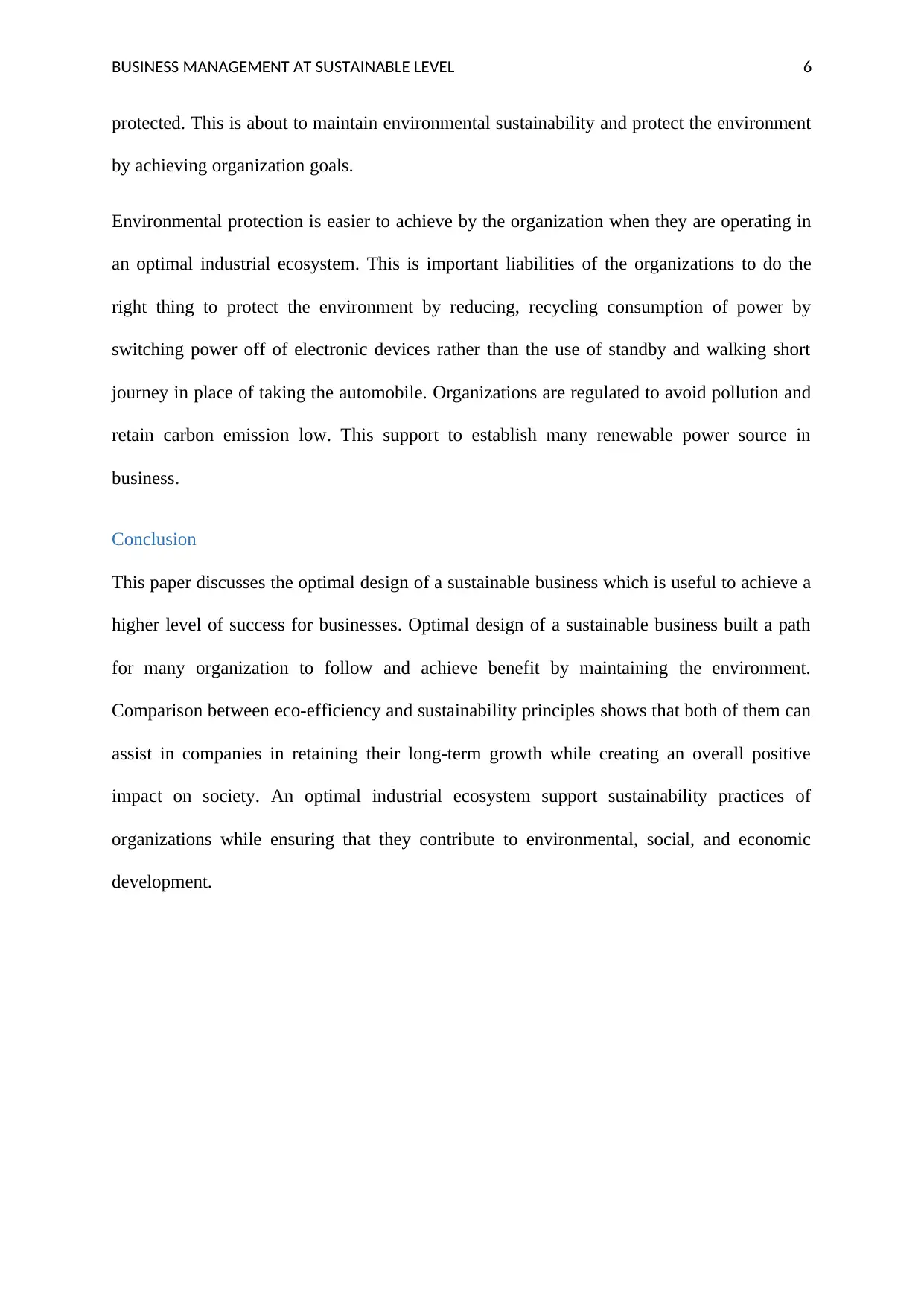
BUSINESS MANAGEMENT AT SUSTAINABLE LEVEL 6
protected. This is about to maintain environmental sustainability and protect the environment
by achieving organization goals.
Environmental protection is easier to achieve by the organization when they are operating in
an optimal industrial ecosystem. This is important liabilities of the organizations to do the
right thing to protect the environment by reducing, recycling consumption of power by
switching power off of electronic devices rather than the use of standby and walking short
journey in place of taking the automobile. Organizations are regulated to avoid pollution and
retain carbon emission low. This support to establish many renewable power source in
business.
Conclusion
This paper discusses the optimal design of a sustainable business which is useful to achieve a
higher level of success for businesses. Optimal design of a sustainable business built a path
for many organization to follow and achieve benefit by maintaining the environment.
Comparison between eco-efficiency and sustainability principles shows that both of them can
assist in companies in retaining their long-term growth while creating an overall positive
impact on society. An optimal industrial ecosystem support sustainability practices of
organizations while ensuring that they contribute to environmental, social, and economic
development.
protected. This is about to maintain environmental sustainability and protect the environment
by achieving organization goals.
Environmental protection is easier to achieve by the organization when they are operating in
an optimal industrial ecosystem. This is important liabilities of the organizations to do the
right thing to protect the environment by reducing, recycling consumption of power by
switching power off of electronic devices rather than the use of standby and walking short
journey in place of taking the automobile. Organizations are regulated to avoid pollution and
retain carbon emission low. This support to establish many renewable power source in
business.
Conclusion
This paper discusses the optimal design of a sustainable business which is useful to achieve a
higher level of success for businesses. Optimal design of a sustainable business built a path
for many organization to follow and achieve benefit by maintaining the environment.
Comparison between eco-efficiency and sustainability principles shows that both of them can
assist in companies in retaining their long-term growth while creating an overall positive
impact on society. An optimal industrial ecosystem support sustainability practices of
organizations while ensuring that they contribute to environmental, social, and economic
development.
Paraphrase This Document
Need a fresh take? Get an instant paraphrase of this document with our AI Paraphraser
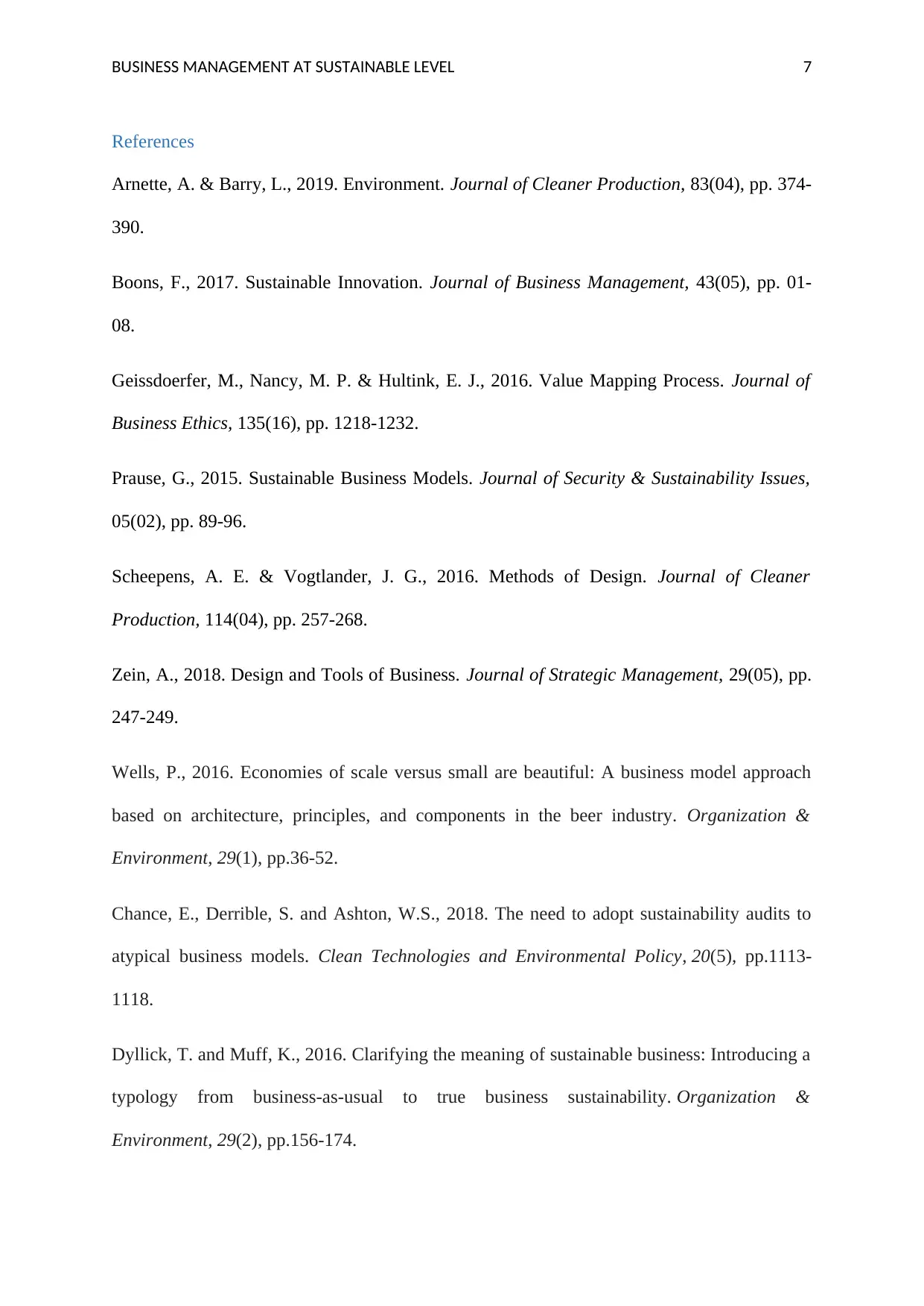
BUSINESS MANAGEMENT AT SUSTAINABLE LEVEL 7
References
Arnette, A. & Barry, L., 2019. Environment. Journal of Cleaner Production, 83(04), pp. 374-
390.
Boons, F., 2017. Sustainable Innovation. Journal of Business Management, 43(05), pp. 01-
08.
Geissdoerfer, M., Nancy, M. P. & Hultink, E. J., 2016. Value Mapping Process. Journal of
Business Ethics, 135(16), pp. 1218-1232.
Prause, G., 2015. Sustainable Business Models. Journal of Security & Sustainability Issues,
05(02), pp. 89-96.
Scheepens, A. E. & Vogtlander, J. G., 2016. Methods of Design. Journal of Cleaner
Production, 114(04), pp. 257-268.
Zein, A., 2018. Design and Tools of Business. Journal of Strategic Management, 29(05), pp.
247-249.
Wells, P., 2016. Economies of scale versus small are beautiful: A business model approach
based on architecture, principles, and components in the beer industry. Organization &
Environment, 29(1), pp.36-52.
Chance, E., Derrible, S. and Ashton, W.S., 2018. The need to adopt sustainability audits to
atypical business models. Clean Technologies and Environmental Policy, 20(5), pp.1113-
1118.
Dyllick, T. and Muff, K., 2016. Clarifying the meaning of sustainable business: Introducing a
typology from business-as-usual to true business sustainability. Organization &
Environment, 29(2), pp.156-174.
References
Arnette, A. & Barry, L., 2019. Environment. Journal of Cleaner Production, 83(04), pp. 374-
390.
Boons, F., 2017. Sustainable Innovation. Journal of Business Management, 43(05), pp. 01-
08.
Geissdoerfer, M., Nancy, M. P. & Hultink, E. J., 2016. Value Mapping Process. Journal of
Business Ethics, 135(16), pp. 1218-1232.
Prause, G., 2015. Sustainable Business Models. Journal of Security & Sustainability Issues,
05(02), pp. 89-96.
Scheepens, A. E. & Vogtlander, J. G., 2016. Methods of Design. Journal of Cleaner
Production, 114(04), pp. 257-268.
Zein, A., 2018. Design and Tools of Business. Journal of Strategic Management, 29(05), pp.
247-249.
Wells, P., 2016. Economies of scale versus small are beautiful: A business model approach
based on architecture, principles, and components in the beer industry. Organization &
Environment, 29(1), pp.36-52.
Chance, E., Derrible, S. and Ashton, W.S., 2018. The need to adopt sustainability audits to
atypical business models. Clean Technologies and Environmental Policy, 20(5), pp.1113-
1118.
Dyllick, T. and Muff, K., 2016. Clarifying the meaning of sustainable business: Introducing a
typology from business-as-usual to true business sustainability. Organization &
Environment, 29(2), pp.156-174.
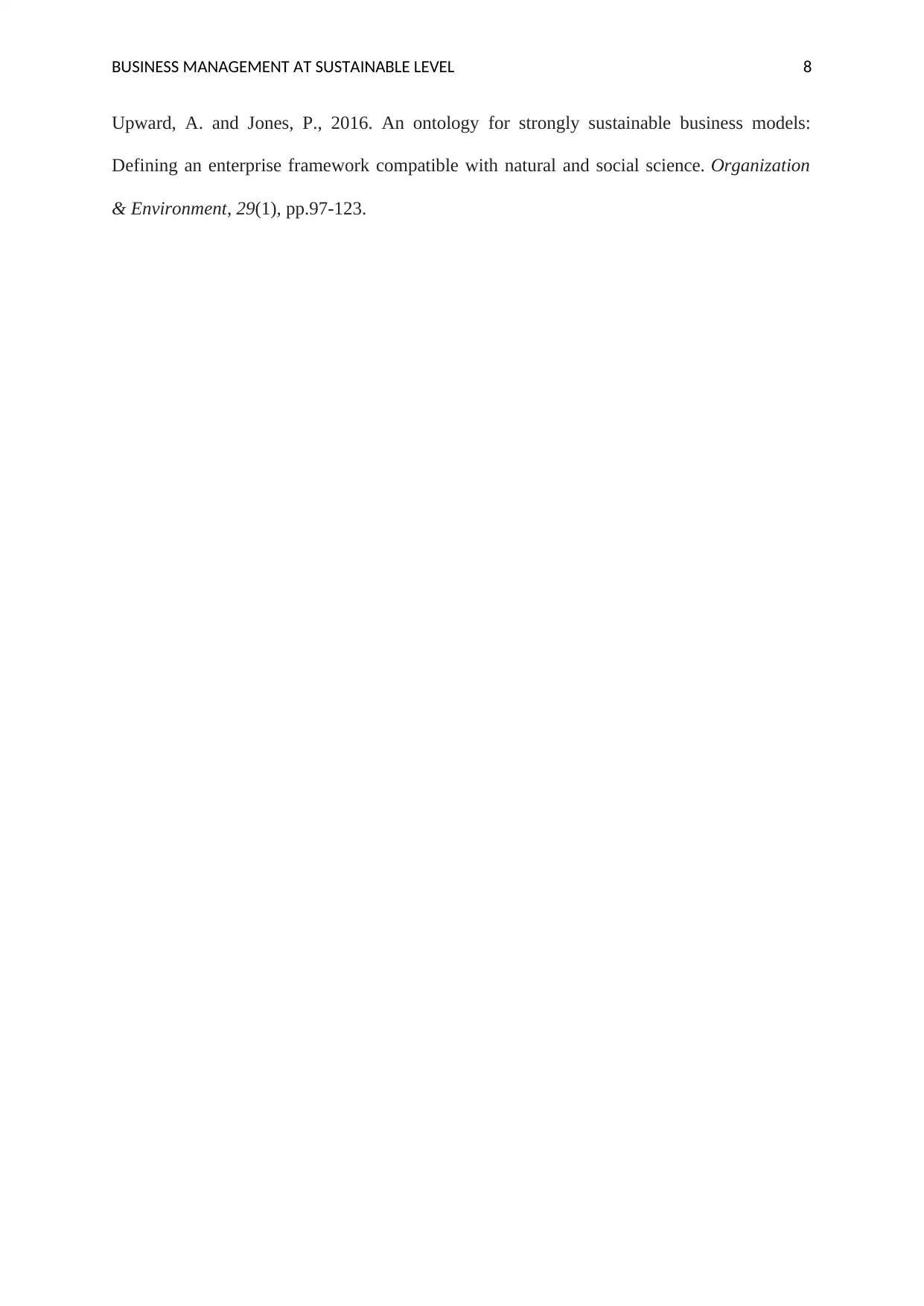
BUSINESS MANAGEMENT AT SUSTAINABLE LEVEL 8
Upward, A. and Jones, P., 2016. An ontology for strongly sustainable business models:
Defining an enterprise framework compatible with natural and social science. Organization
& Environment, 29(1), pp.97-123.
Upward, A. and Jones, P., 2016. An ontology for strongly sustainable business models:
Defining an enterprise framework compatible with natural and social science. Organization
& Environment, 29(1), pp.97-123.
⊘ This is a preview!⊘
Do you want full access?
Subscribe today to unlock all pages.

Trusted by 1+ million students worldwide
1 out of 9
Related Documents
Your All-in-One AI-Powered Toolkit for Academic Success.
+13062052269
info@desklib.com
Available 24*7 on WhatsApp / Email
![[object Object]](/_next/static/media/star-bottom.7253800d.svg)
Unlock your academic potential
Copyright © 2020–2025 A2Z Services. All Rights Reserved. Developed and managed by ZUCOL.





